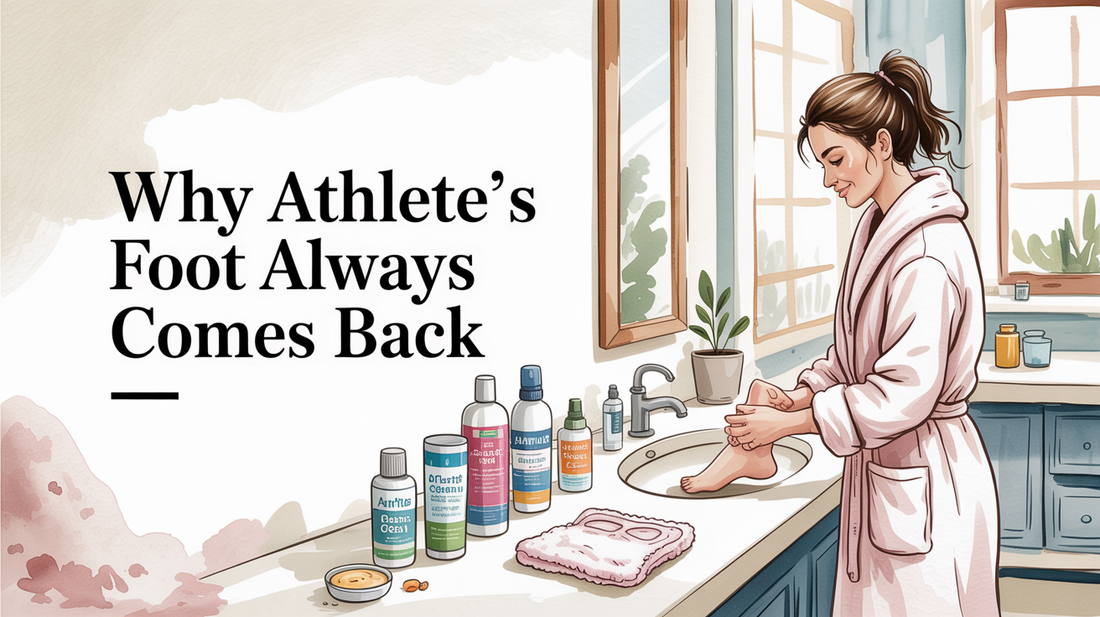Why does athlete’s foot keep coming back?
recurrent athlete’s foot, reinfection, shoe contamination — If you’ve experienced the frustration of recurrent athlete’s foot, you’re not alone. Many individuals face the challenge of reinfection, often due to shoe contamination and other hidden sources. This post is organized into three clear sections, providing actionable insights to help you tackle this issue effectively.
Missed sources 🧭
Recurrent athlete’s foot can often be traced back to overlooked sources of reinfection. The fungus that causes this condition can thrive in warm, damp environments, making it crucial to identify potential hotspots in your surroundings. Contaminated shoes and socks may harbor lingering spores if they weren't properly treated, creating ongoing exposure risks.
Shared surfaces, such as gym floors and pool decks, are common breeding grounds for this fungus. Additionally, household members could unknowingly carry the infection, exacerbating the issue. Personal items like towels and nail clippers can also be culprits, as well as pets that may transmit fungal infections to humans.
- Check shoes and socks for contamination; treat them thoroughly.
- Avoid walking barefoot in shared public spaces.
- Ensure personal items like towels are washed frequently.
- Regularly groom pets and monitor their foot health.
- Encourage family members to maintain foot hygiene.
Try It Tonight: Calm, Fresh Feet ✨
- Wash feet with warm water and mild cleanser; dry thoroughly between toes.
- Apply a small amount of Kissable Feet where needed; massage until absorbed.
- Let skin breathe; slip on breathable socks if desired. Patch-test first if you’re new to this foot cream.
Treatment mistakes ✨
Many individuals encounter treatment failures due to common mistakes that can lead to incomplete care. For example, stopping antifungal treatment prematurely can allow the infection to linger, while some over-the-counter remedies might not be potent enough for persistent cases. Applying medications inconsistently or incorrectly may also contribute to the problem.
Consider this scenario: if only one foot shows symptoms, neglecting to treat both can lead to the fungus spreading. Additionally, underlying conditions like compromised immunity might complicate treatment, making it essential to address these factors to enhance effectiveness.
- Complete the full course of treatment, even if symptoms improve.
- Choose stronger antifungal options when necessary.
- Apply topical medications consistently to all affected areas.
- Treat both feet to prevent spreading the infection.
- Consult a healthcare provider if underlying conditions exist.
Why We Recommend a Gentle Helper 🌿
Kissable Feet is designed for quick absorption and a soothing experience, featuring a blend of tea tree, coconut, and calendula. This nurse-crafted formula is gentle on the skin, providing relief and support for your nightly routine.
- Fast-absorbing comfort—non-greasy finish.
- Gentle sensation suited for sensitive, overworked feet.
- Clean-leaning, bedtime-friendly scent.
Long-term prevention 🔍
To effectively prevent reinfection, it's vital to foster an environment that is inhospitable to fungal growth. Simple yet consistent foot hygiene practices can make a significant difference. Keeping feet dry, particularly between the toes, is crucial, along with changing socks regularly to avoid dampness.
Using antifungal powder in shoes can help reduce moisture. Opting for breathable socks and shoes made from moisture-wicking materials will further support foot health. In public areas, wearing protective footwear like flip-flops can safeguard against exposure.
- Always dry feet thoroughly after washing, especially between toes.
- Rotate shoes to allow them to air out completely.
- Invest in moisture-wicking socks for better foot health.
- Wear protective footwear in communal areas.
- Disinfect or replace items used during infections to avoid recontamination.

